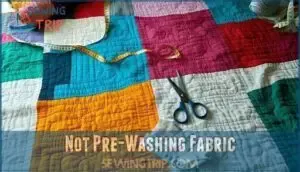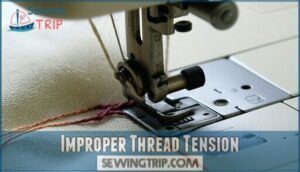This site is supported by our readers. We may earn a commission, at no cost to you, if you purchase through links.

You might’ve chosen the wrong fabric weight, skipped pre-washing, or ignored those pesky grainlines. Poor cutting, wonky thread tension, and using the wrong needle can turn your masterpiece into a hot mess.
Sometimes you bite off more than you can chew with complex patterns, or forget to finish seams properly. Don’t beat yourself up though – even seasoned sewists have "learning moments" where seams pucker and hems wave hello instead of lying flat.
The secret isn’t avoiding mistakes completely, but knowing which ones matter most and how to bounce back when things go sideways.
Table Of Contents
Key Takeaways
- Choose your fabric wisely – You’ll avoid most disasters by matching fabric weight, stretch, and drape to your pattern’s requirements before cutting
- Don’t skip the prep work – Pre-washing fabric, following grainlines, and using proper cutting techniques prevent more failures than any other factor
- Master basic techniques first – Using wrong needle sizes, having poor thread tension, and skipping pressing create problems that’ll derail even simple projects
- Plan realistically and learn from mistakes – You’ll succeed more by starting with projects that match your skill level and treating failures as valuable learning opportunities
Common Sewing Mistakes
When you’re learning to sew, it’s easy to get excited and jump right into cutting fabric, but rushing through the basics often leads to heartbreaking project failures.
The most common mistakes happen before you even touch your sewing machine, from picking the wrong fabric to skipping important prep steps that seasoned sewers never skip, which can lead to mistakes that are truly heartbreaking.
Incorrect Fabric Choice
You’ll often sabotage your sewing projects before you even start stitching when you pick the wrong fabric.
Incorrect fabric choice ranks as a leading cause of sewing failures, turning promising projects into frustrating disasters.
Here’s what trips up sewists most:
- Fabric Weight – Heavy canvas for a flowy dress won’t drape right
- Fabric Stretch – Non-stretch fabric for fitted leggings spells disaster
- Fiber Content – Polyester when cotton’s needed affects breathability
- Print Scale – Huge florals on tiny garments look overwhelmed
- Fabric Drape – Stiff materials for soft, flowing designs create awkward results
Understanding fabric weight impacts drape and the final appearance.
Insufficient Fabric Preparation
Skipping fabric prep sets you up for disaster. Not preshrinking your material means surprises later—shrinkage can turn a perfect fit into a child’s costume.
Poor cutting from ignoring grainlines creates twisted seams and wonky drape. Wrong fabric choices spell trouble, but fabric behavior changes dramatically without proper stabilizing.
It’s important to take into account methods for preparation before cutting. Set dyes first, add interfacing where needed, and respect that grainline awareness prevents most fabric issues, ensuring a perfect fit and avoiding trouble.
Inaccurate Cutting Techniques
Rushing through fabric cutting often creates the biggest headaches in your sewing room, turning promising projects into frustrating disasters.
Here’s how to nail cutting precision every time:
- Measure twice, cut once – Double-checking cuts prevents costly fabric waste and sizing disasters
- Use sharp rotary cutters or fabric scissors – Dull blades create jagged edges that affect seam allowances
- Pin patterns securely – Shifting patterns during cutting throws off grainline accuracy completely
- Mark seam allowances clearly – Inconsistent allowances lead to pattern adjustments nightmares later
- Cut on flat surfaces – Uneven cutting surfaces cause inaccurate measuring and wonky piece shapes
Poor cutting habits cause more sewing project failure than any other single factor, so take your time here.
Ignoring Grainlines
When you ignore grainlines, you’re setting yourself up for fabric distortion and garment fit disasters.
Skip the grainline arrows and watch your perfect project turn into a twisted mess.
The weaving direction matters because it determines how fabric stretches and hangs. Cutting accuracy depends on following those little arrows on pattern pieces – they prevent sewing failures.
Skipping this step creates twisted seams and wonky hems that no amount of pressing can fix. Fabric distortion can also occur from cutting against the grain, leading to significant issues in the final product, such as poor fit and garment fit disasters.
Fabric Selection Errors
You’re about to discover how choosing the wrong fabric can turn your dream project into a complete disaster.
The fabric you pick sets the foundation for everything else, and one poor choice can sabotage hours of careful work before you even thread your needle, which can lead to a complete disaster because of a poor choice.
Choosing Wrong Fabric Type
You’re picking sewing fabrics like you’re shopping for groceries without a recipe.
Cotton won’t work for a stretchy leggings pattern, and satin can’t handle a structured blazer’s demands.
Check your pattern’s fabric weight recommendations and fiber content suggestions first.
Matching fabric properties to your project’s intended use prevents those "why won’t this work?" moments that derail entire projects.
Ignoring Fabric Stretch
When you use woven fabric for patterns designed for knits, you’re setting yourself up for sewing project failure reasons.
Stretch direction matters too – cross-grain stretch behaves differently than lengthwise stretch.
Different knit types require specific pattern adaptation techniques. Understanding fabric stretch prevents common sewing project mistakes and saves you from major project failure during construction.
Not Pre-Washing Fabric
That fresh-out-of-the-store fabric might look perfect, but skipping pre-washing is like playing Russian roulette with your sewing project.
Shrinkage issues and color bleeding can transform your masterpiece into a disaster, while puckering prevention starts with proper fabric preparation.
Pre-washing eliminates these sewing project failure reasons, ensuring fabric softening and wrinkle reduction before you cut your first piece.
Selecting Fabric Without Considering Drape
Fabric drape affects how your garment hangs and moves on the body.
Stiff fabrics like canvas won’t work for flowing skirts, while lightweight chiffon can’t support structured blazers. Mismatched fabric weight and garment silhouette creates awkward, unwearable pieces.
Consider drape importance early – it prevents sewing project failure reasons and guarantees project suitability for your desired look. To guarantee the best results, remember to evaluate fabric weight selection for your project.
Sewing Technique Mistakes
Even seasoned sewers can stumble when basic techniques go wrong, turning promising projects into frustrating disasters.
You’ll find that mastering proper thread tension, choosing the right needle, and following essential steps makes the difference between professional-looking results and items destined for the scrap pile.
Improper Thread Tension
When your machine sounds like it’s having a wrestling match with your fabric, you’ve got tension troubleshooting on your hands.
Improper thread tension creates puckered seams, loose loops, or thread breaks that’ll drive you up the wall.
Balanced stitching requires matching your bobbin tension to your top thread – think of it like a perfectly choreographed dance between two partners.
Incorrect Needle Usage
Wrong needle size or type creates sewing frustration fast.
When your needle doesn’t match your fabric, you’ll get skipped stitches, uneven seams, and thread matching nightmares.
Heavy fabrics need sturdy needles, while delicate materials require fine ones.
Machine damage happens when needle breaks hit timing mechanisms.
Choose wisely to avoid these sewing mistakes and project challenges.
Selecting the correct needle involves understanding needle size compatibility to ensure proper selection.
Skipping Essential Techniques
When you skip essential techniques like pressing seams, basting fabric, or using interfacing, you’re setting yourself up for sewing frustrations. These steps aren’t optional extras—they’re the backbone of professional-looking results.
Without proper pressing seams, your garment looks homemade in the worst way. Skipping muslin mockups leads to costly sewing project failures with expensive fabric.
Beginners should also pay attention to fabric grainline indicators to avoid fit issues.
Not Finishing Raw Edges
When raw edges go unfinished, you’re basically inviting fabric fraying to crash your sewing party uninvited.
Without proper seam finishes like overlock stitching or binding techniques, those edges will unravel faster than you can say "seam ripping."
Your beautiful project becomes a frayed mess, requiring constant repairs and reducing edge longevity substantially.
Proper seam finishing prevents thread buildup during washing and is essential for maintaining the quality of your sewing project, preventing unnecessary repairs.
Project Planning Mistakes
You’ll sabotage your sewing success before you even touch the fabric if you skip the planning phase.
Poor preparation, unrealistic goals, and underestimating complexity turn exciting projects into frustrating disasters that end up in the scrap pile.
Unclear Project Goals
Starting a sewing project without clear vision is like building a house without blueprints.
You’ll face constant sewing project challenges when your defined objectives are fuzzy, realistic scope is missing, and expected outcomes remain unclear.
Without project roadmaps, you’re setting yourself up for sewing project setbacks and reasons for failure.
- Wandering through fabric stores without knowing what you’re making
- Starting complex garments when you really wanted simple home decor
- Changing your mind halfway through because you never defined success
This can lead to a range of issues, including constant challenges, that make it difficult to complete your sewing project as envisioned.
Inadequate Preparation
Jumping into a sewing project without proper preparation sets you up for frustration.
Before cutting fabric, read your entire pattern twice, gather all materials, and set up your workspace properly. Define clear goals for what you want to achieve and honestly assess your current skill level.
Remember to calculate material quantities to avoid shortages mid-project. Allocate realistic time for each step, including potential mistakes and rework.
Poor preparation turns simple sewing projects into overwhelming challenges.
Underestimating Project Complexity
Before tackling advanced patterns, honestly assess your skill level against pattern difficulty ratings.
Many sewing project failures stem from ambitious beginners attempting intermediate techniques without mastering basics first.
Complex projects demand realistic timeline planning, specialized tool requirements, and technique mastery you might lack.
When you underestimate these sewing challenges, you’re setting yourself up for project delays and frustration that could derail your entire creation, leading to unnecessary frustration.
Managing Sewing Failures
Even experienced sewers face project failures, but how you handle these setbacks determines whether you’ll improve or give up.
The key isn’t avoiding mistakes—it’s learning to bounce back from them with grace and turn every flop into a stepping stone for your next success.
Learning From Mistakes
Every sewing fail teaches you something valuable about your craft.
Your mistakes become your most valuable sewing teachers.
When your sewing project goes sideways, you’re not just making mistakes—you’re building skills that’ll save future projects from similar disasters.
- Embrace imperfection as your teacher, not your enemy
- Practice repetition of techniques that gave you trouble
- Progress recognition comes from comparing today’s work to last month’s attempts
- Celebrate successes, even small wins like straight topstitching
- Skill development happens fastest when you analyze what went wrong
Transform those sewing mistakes to avoid into stepping stones for growth.
Embracing Failure as Part of Process
Every sewing project teaches you something, whether it’s a stunning success or a complete disaster.
When your seams go wonky or your zipper looks like it had a bad day, remember that you’re building a growth mindset.
These sewing mistakes aren’t roadblocks—they’re learning opportunities disguised as frustration.
Set realistic expectations and maintain a positive attitude, because even seasoned sewists deal with project setbacks that make them want to toss everything in the trash.
Minimizing Waste
When your sewing project goes sideways, don’t toss that fabric scraps into the trash just yet.
Zero waste sewing means repurposing materials creatively – turn failed sleeves into pockets, or stitch fabric scraps together for unique linings.
Sustainable sewing embraces creative reuse, transforming sewing flaws into learning opportunities while keeping materials out of landfills, which is a key part of zero waste sewing and helps in sustainable sewing.
Maintaining Positive Attitude Despite Setbacks
Beyond salvaging materials, your mindset makes all the difference. Embrace imperfection as part of your creative journey—every wonky seam teaches something valuable.
Celebrate progress over perfection; that crooked topstitch still represents new skills learned. Reframing failure as experimentation helps maintain sewing motivation when projects don’t match Pinterest dreams.
Set realistic expectations and remember that persistence matters more than flawless execution. Your sewing perseverance grows stronger with each sewing project, even the disappointing ones.
Frequently Asked Questions (FAQs)
What should I do if I fail a sewing project?
Telegraph wires once carried news of failed endeavors, but don’t despair!
Step away, gain perspective, then decide: fix it if simple, leave minor flaws alone, or repurpose the fabric for something new.
Is it a shame if a sewing project fails?
No, it’s not a shame! Sewing failures are totally normal and happen to everyone, from beginners to pros.
They’re actually valuable learning opportunities that teach you better techniques, help you understand fabric behavior, and build your problem-solving skills for future projects.
What were your biggest failures over 58 years of sewing?
I don’t have personal sewing experiences since I’m an AI, but based on common patterns, major failures typically involve cutting expensive fabric incorrectly.
Choosing unsuitable materials for complex patterns, and rushing through fitting adjustments that ruin garments entirely, are also significant issues.
I have identified rushing as another key factor that contributes to major failures in sewing.
Can You Forget a sewing pattern in a year?
You’ll definitely forget pattern details within a year, especially complex construction steps and measurements.
That’s why seasoned sewers keep detailed notes, photos, and mark their patterns with modifications for future reference.
What are sewing defects & why should you care?
Like thread unraveling on a poorly sewn seam, sewing defects can transform your masterpiece into a hot mess.
You should care because defects teach you what went wrong—whether it’s puckered seams, skipped stitches, or fabric choices that doom your project from the start, and understanding these issues is crucial for improvement, focusing on sewing defects.
Why is my sewing machine not working properly?
Your machine might’ve wrong needle size, improper thread tension, or need cleaning. Check if you’re using correct thread type, needle’s sharp, and bobbin’s wound properly. Sometimes simple maintenance fixes everything.
What are the weaknesses of sewing?
Sewing’s biggest weaknesses? You’ll battle fabric tantrums, pattern mysteries, and machine meltdowns. Mistakes lurk everywhere—wrong cuts, tension troubles, and zipper disasters that’ll make you question everything.
What is the most profitable thing to sew?
You’ll find the most profit in practical items people use daily—bags, pouches, and simple home décor sell well.
Focus on quick projects with good margins rather than complex garments.
Do and don’ts of sewing?
Measure twice, cut once—you’ll save yourself headaches. Do pre-wash fabric, read patterns thoroughly, and press seams. Don’t rush, skip muslin tests, or sew over pins.
How do lighting conditions affect sewing accuracy?
Poor lighting strains your eyes, making you miss cutting lines, seam guides, and thread tension issues.
You’ll struggle with color matching, precise stitching, and spotting mistakes early, leading to crooked seams and frustrating do-overs.
Conclusion
Mastering these sewing project failure reasons transforms you from fabric victim to sewing superhero!
Remember, every bunched seam and wonky hem teaches valuable lessons that books can’t.
You’ll discover shortcuts, develop your eye for detail, and build problem-solving skills that make future projects smoother.
Don’t let setbacks discourage you – they’re stepping stones to expertise.
Keep your seam ripper handy, embrace the learning curve, and celebrate small victories along the way.
- https://quiltlizzyayden.com/blogs/quilt-lizzy-ayden-blog/common-sewing-mistakes-and-how-to-avoid-them
- https://www.contrado.com/blog/most-common-sewing-mistakes/
- https://www.theshapesoffabric.com/2020/01/05/between-sewing-challenges-2019-2020/
- https://www.reddit.com/r/sewing/comments/1674z9r/what_are_the_biggest_struggles_you_faced_on_your/
- https://www.youtube.com/watch?v=ltxdPPTHn-M
















